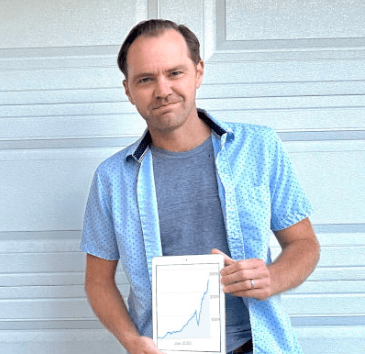How Kristin Jacobsen Sold Connected Wealth for 6 Figures and Pivoted Into Exit Consulting


Business Description
Table of Contents
Navigate through the case study sections
Executive Summary
Case Study Content
Kristin Jacobsen: From Accountant to Six-Figure Exit in Online Financial Planning
Kristin Jacobsen never settled for the status quo. After picking up an accounting degree in 2011, he landed at Australia’s largest financial services company. The corporate world taught him about regulatory headaches and slow-moving change. But it also revealed a glaring gap: no one was offering modern, accessible money advice for Australia’s up-and-coming high earners. That gap quickly grew to an itch he needed to scratch.
Spotting Opportunity Where Others Missed
In 2013, Jacobsen founded Connected Wealth with one goal: serve young professionals with high incomes but low asset bases in a way that fits their real lives. Most old-school financial advisors ignored this crowd, chasing big, older clients with sizable portfolios. Jacobsen understood tastes had shifted, Gen Y valued digital meetings, wanted admin done online, and didn’t have time for paper forms or office visits.
He capitalized on these preferences by crafting advice sessions held over Zoom, slashing admin time with paperless onboarding, and integrating personal finance apps into the experience. The business promised expert guidance, but on clients' terms: fast, transparent, and uncompromisingly virtual.
Marketing That Actually Clicked
Jacobsen’s strategy to grow wasn’t just about smart advice; it was about getting in front of the right prospects. In an industry clinging to brochure drops and lunch seminars, he took another approach: social advertising. Running targeted Facebook and Instagram ads, he landed early leads while his competitors were still updating Yellow Pages.
But he didn’t stop there. He knew his audience spent more time online than reading direct mail, so Connected Wealth hosted webinars, built a content-rich blog, and put out digital tools tailor-made for salaried professionals. There were in-person meetups, too, but these were selective, value-focused, and built trust faster than another free dinner at a cheesy steakhouse.
Building a Lean, Tech-First Team
Things exploded quickly, and Jacobsen faced that very modern founder problem: wearing too many hats was no longer sustainable. The first solution? Virtual assistants (VAs) specializing in financial services. Jacobsen initially tried generalist VAs and got nowhere, one mistake after another. Switching to specialist VAs, sourced from a B2B service, instantly improved results.
To focus on what he did best (client relationships, sales, and marketing), he brought in a technical manager. This role covered compliance, technical analysis, and handled all the fiddly, high-risk finserv work. Freed from back-office distractions, Jacobsen was able to pour energy into winning and keeping clients.
Facing Industry Headwinds and Making the Call to Sell
Eight years in, the business hummed, but new industry rules brought wave after wave of compliance headaches. These changes ramped up cost and risk, but didn’t improve outcomes for customers. Jacobsen, seeing diminishing returns for more effort, realized he’d hit his personal ceiling for growth. Scaling further required more infrastructure, more staff, and a risky capital outlay.
Instead, Jacobsen decided to “cash in his chips.” Connected Wealth had a pre-purchase deal with its license provider, effectively a built-in buyer if external offers disappointed. He tested the waters with his own network, but found that outside bids undercut the guaranteed offer. Choosing certainty over endless negotiation, he sold the business for a multiple six-figure sum at 4x EBITA.
Lessons From a Stressful Exit Process
Despite planning for a smooth exit, Jacobsen says the sale was the most stressful and resource-draining project he’d ever tackled. The supposed safety of a pre-purchase agreement turned sour, as the buyer tried repeatedly to reduce the sale price or tinker with terms. Nothing replaced the peace of mind of having an experienced business broker, Jacobsen had wanted to save money by going solo, but learned just how many pitfalls lurked in the exit process.
The sale finally completed at the agreed terms. Connected Wealth’s customer-centric digital model made it attractive even in a nervous market; strong profit, solid systems, and a loyal client list sealed the deal.
Becoming the Guide for Other Founders
The intensity of the sale experience stuck with Jacobsen. He pivoted careers, joining Flippa as a Business Development Representative and Exit Advisor. Now he coaches other founders, with a deep focus on the human side. Many, like him, struggle most with the transition after the sale: giving up a personal passion, shifting identity, and figuring out “what now.” Jacobsen helps them prep not just documents and data rooms, but their own mindset for whatever comes next.
Today’s Market and What’s Next
Jacobsen says buyers are more skeptical post-2023, after Google’s algorithm changes forced content websites to focus on E-E-A-T (Experience, Expertise, Authority, Trust). Good online businesses can still command strong multiples, but owners with sloppy ops or thin content shouldn’t expect easy exits.
For sellers: treat your site or digital service like a real business, keep compliance tight, and build a recognizable brand. The shift to cautious money is here; only the solid deals get snapped up fast.
Takeaways and Advice for Founders
- Find an underserved audience with a big pain point
- Use technology to make every interaction easier (for both client and team)
- Get the right help, specialist VAs saved hours and error costs
- Test your growth limits before risking everything on a huge scale-up
- Plan exits early and, if possible, use an expert broker
- Be ready for big emotional shifts once the deal closes, but know new opportunities will come fast.
Jacobsen’s story shows that you don’t need to follow a classical path or build a unicorn to change your life. Sometimes, a tight focus, operational savvy, and smart timing matter more than building a household name.
Key Takeaways
- 1Identifying specific demographic needs can unlock rapid growth in the financial sector, even against established incumbents.
- 2Leveraging social media and online events can outpace traditional marketing methods for attracting digital-savvy clients.
- 3Specialist virtual assistants dramatically improved efficiency and freed founders to focus on growth and sales.
- 4Industry compliance changes can force tough decisions; know your limits, and plan exit strategies early.
- 5A pre-purchase agreement can provide certainty but may lead to conflicts or last-minute negotiation tactics by the buyer.
- 6Seeking professional help during an exit (like a business broker) can save time, money, and significant emotional stress.
Key Facts
Tools & Technologies Used
Premium Content Locked
Subscribe to access the tools and technologies used in this case study.
Unlock NowHow to Replicate This Success
Premium Content Locked
Subscribe to access the step-by-step replication guide for this case study.
Unlock NowInterested in Being Featured?
Share your success story with our community of entrepreneurs.
Explore More Case Studies
Discover other inspiring business success stories

How Eddie Eastman Built a 6-Figure Business Selling Ready-Made Online Stores
Eddie Eastman wasn't always a tech founder, he started as a survivalist, but pivoted to building and selling digital Sho...
Startup Streams

How Jared Bauman Scaled His Newsletter Portfolio With A Strategic Acquisition
Jared Bauman, host of Weekend Growth and co-owner of 201 Creative, acquired The Slice newsletter to tap into a similar e...
Weekend Growth

How One Store Hit $125K/Month with Google Ads
Gary Lim built a Shopify dropshipping store focused on sub-$100 smartwatches that delivered $126K revenue in one month. ...
GL Smartwatch Store